America - Orient
San Francisco - Far East
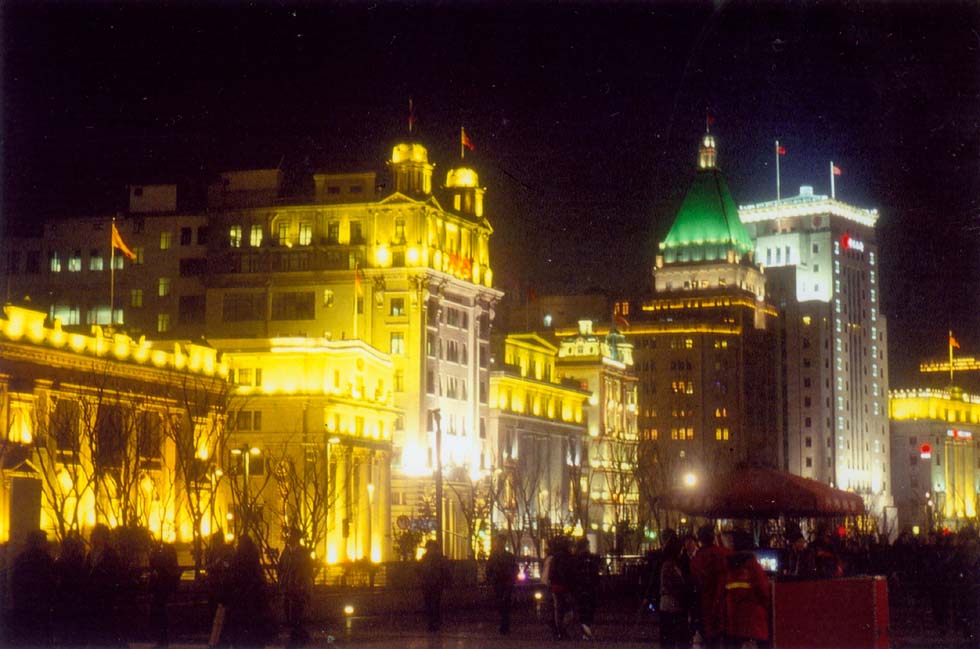
Shanghai, the Bund, 2011 (WS)
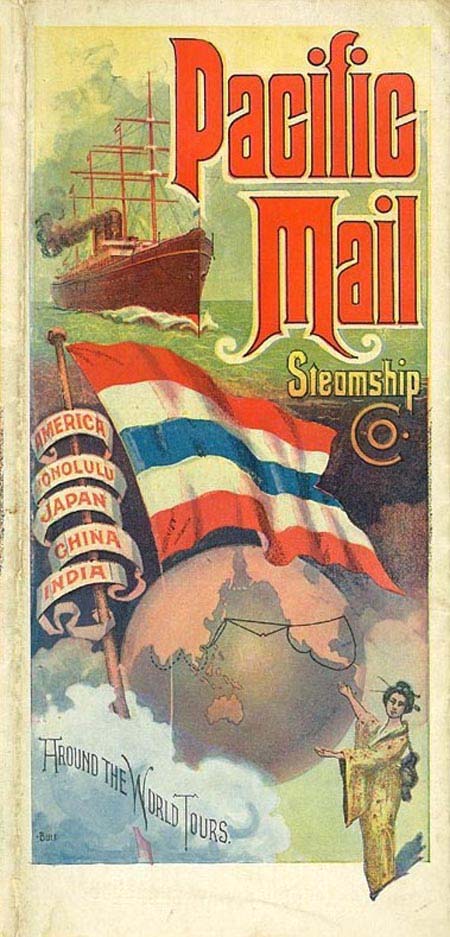
PMSSCo ad (via timetableimages)
|
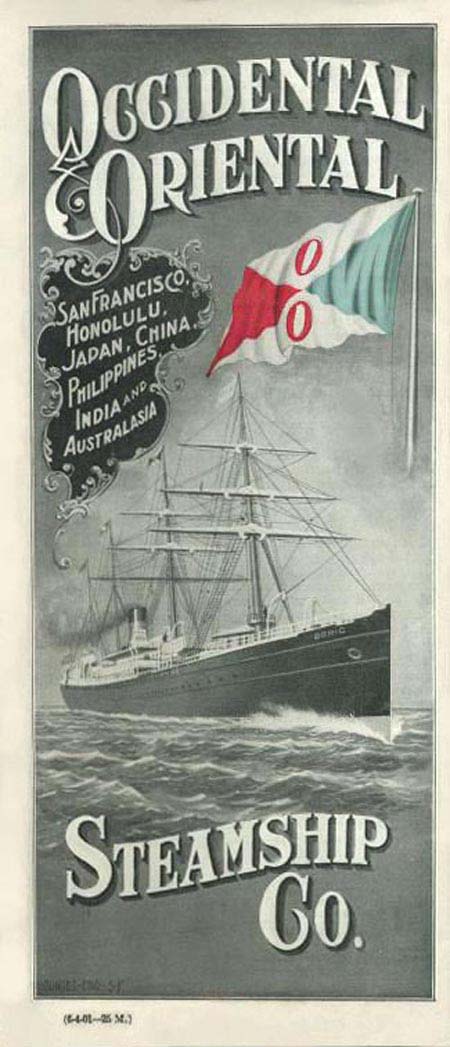
O&O ad 1901 (via timetableimages)
|
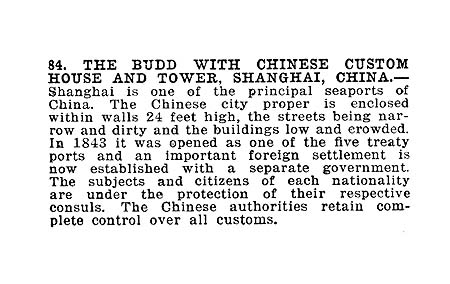
|
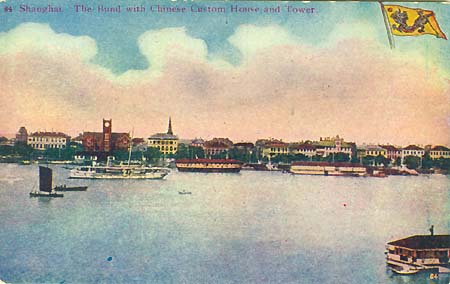
Shanghai, the Bund, before WWI (old card, coll. WS)
|
The first American mail contract for services from San Francisco to the Far East had been awarded in 1865 to the Pacific Mail Steamship Co., the PMSSCo. As the first mail steamers for the Pacific the "California", "Oregon" and "Panama" were recorded (by TheShipsList). The first regular mail voyage to Yokohama and Hong Kong was undertaken by the steamer "Colorado" in 1867. A feeder service to Shanghai connected at Yokohama. The company, incorporated already in 1848 by the Senate of New York, had immediately started services from Oregon and then also from the US East Coast to Panama (see chapter South Atlantic/ Caribbean). White Star of Liverpool maintained a San Francisco - Yokohama - Hong Kong route between 1875 and 1883, then replaced by a service Liverpool - New Zealand on the other way via the Cape of Good Hope. From 1874, an attempt by a China Trans-Pacific SSCo. to charter White Star steamers for Pacific services is reported.
The Oriental & Occidental Steamship Co. (O&O) was founded in 1875 by the Union Pacific and the Southern Pacific Railroad, which had completed the transcontinental rail link across the USA in 1869 as a competitor to the PMSSCo, which offered the longer way via the cooperating Panama Rail Road (see chapter South Atlantic/ Caribbean). The O&O initially used steamers chartered from the White Star Line, the first one being the "Oceanic". In terms with the PMSSCo, the O&O operated a San Francisco - Yokohama - Hong Kong route, later extended to Shanghai and in 1902 to Manila. Around the turn of the century, the "Doric", "Coptic" and "Gaelic" were used on the Hong Kong route. The O&O was virtually taken over by the PMSSCo.
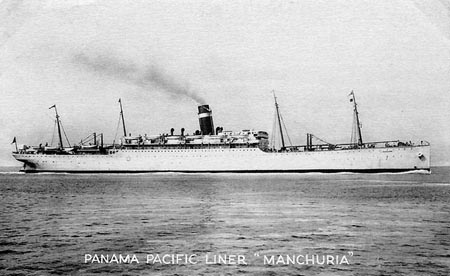 "Manchuria" of PMSSCo (Naval Historical Center, via Wikimedia)
"Manchuria" of PMSSCo (Naval Historical Center, via Wikimedia)
Towards the end of the 19th century, Cook's timetable showed services San Francisco - Yokohama - Nagasaki - Hong Kong by the PMSSCo., alternating with the Oriental & Occidental Steamship Company. The PMSSCo had suffered more and more under that competition and in 1893 the company was taken over by the Southern Pacific Railroad. That railway together with the PMSSCo was acquired in 1901 by Edward A. Harriman, the tycoon who finally owned the railways connecting San Francisco. The "Mongolia" and "Manchuria", advertised as the biggest ships built at that time in the USA, together with the "Korea", "Siberia" and the smaller "China" were employed by the PMSSCo on the Far East route. Due to an anti-trust regulation, the PMSSCo became sold in 1916 to the Grace Line. In 1923, before being acquired by the Dollar SS Line, the PMSSCo employed the "President Cleveland", Lincoln, Pearce, Taft and Wilson on the Hong Kong route.
Only during World War I, from 1917 on, the Rotterdam Lloyd and the SM Nederland services to and from Java temporarily changed to the San Francisco route. Among the lesser known companies at that time was the China Mail SS Co with passenger-cargo services from San Francisco to Japan, Shanghai and Hong Kong.
Far East after WWI
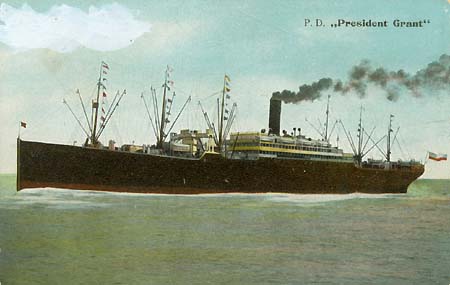
"President Grant" (old card, coll. WS)
|
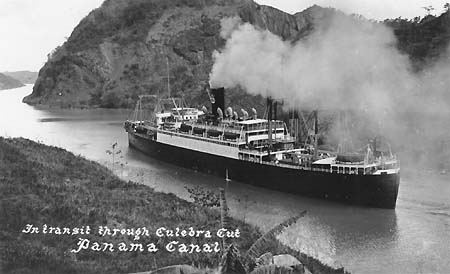
Dollar Line in the Panama Canal (old card, coll. WS)
|
Between the wars, the timetable listed mainly the Dollar Steamship Line on San Francisco - Yokohama - Hong Kong - Manila and other services. Captain Robert Dollar, an American, had started Pacific cargo shipping in 1895. He became a well-known merchantman in the Far East and in 1910 he founded the Dollar Steamship Line. In 1924 the family Dollar acquired the traditional PMSSCo and a goodwill of the Grace Line. In that year the Dollar Line opened a round-the-world service westbound with the "President Harrison", one of the 'President' passenger-cargo steamers. The Pacific SS Co. owned the Admiral Oriental Line, engaged in the Far East trade, too. In 1922 it was taken over by the Dollar Line, listed with the "President Grant" and other steamers. Later it became the American Mail Line. In 1925 the 'President' steamers of the PMSSCo were incorporated into the Dollar fleet. The service to Kobe, Hong Kong and Manila was listed in the timetable e.g. of 1930 as American Mail Line/ Dollar SS Lines. In 1931 the "President Hoover" and "President Coolidge" (21,936 gt, 24.7 knots) were put in service, but the depression had hit the company. In 1937 the "President Hoover" ran aground at Taiwan and was lost. The U.S. Maritime Commission under Chairman Joseph P. Kennedy judged the Dollar Line to be unsound, the government undertook a bailout and assumed control of the company. From 1938 services were run under the new designation American President Lines. Around 1940 these ships helped Americans to return from the Far East in due time before full-scale war started. Weyers Flottentaschenbuch of 1940 mentioned the project of three 35,000-ton passenger ships for Dollar SS Lines, but further information is lacking.
The Seattle Route
The Northern Pacific Railroad serving the northwest of the USA established a connection to the Pacific coast in 1883, but only from 1889 they had an own railway line to Tacoma. Their Northern Pacific Steamship Company was founded under participation of William Pearce Jnr. From 1892 they operated for six years a Tacoma - Yokohama - Hong Kong service with the "Victoria" and "Tacoma", the former Cunarders "Parthia" and "Batavia" of 1870. They had been among the three ships chartered by the Canadian Pacific in 1887 (the "Parthia" had sailed England - Australia in 1885 for Allport & Hughes).
The competing Great Northern Railway of James J. Hill completed another railway to the Pacific coast with Seattle as terminal. Hill's dream of an America - Orient link of his own became true when the "Minnesota" (20,000 gt) of his Great Northern Steamship Co., departed from Seattle to Yokohama and China in January 1905. And his boyhood dreams were realized in December of that year when his de luxe train 'Oriental Limited' was inaugurated between St. Paul and Seattle, connecting with the steamers.
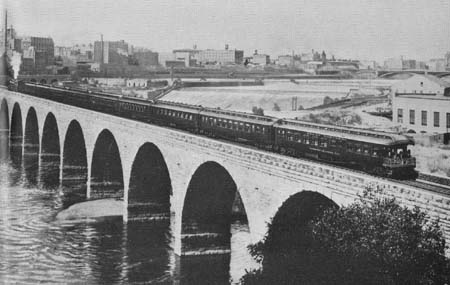
Oriental Limited on the Mississippi Stone Arch Bridge, 1912 (coll. Arthur D. Dubin)
|
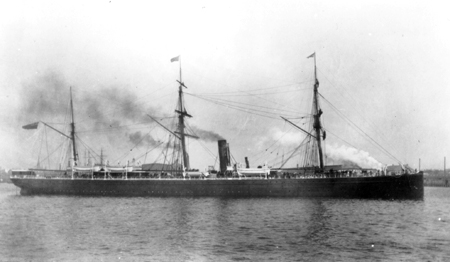
"Parthia" of Cunard (National Maritime Museum, London)
|
James J. Hill obtained control upon his competitor, the Northern Pacific, and later both shipping companies formed the Great Northern Pacific Steamship Co., more renowned for coastal services. The timetable of 1925 showed the connection from Seattle by Nippon Yusen Kaisha twice monthly to Yokohama, Kobe, Nagasaki, Shanghai, Manila and Hong Kong. The passage Seattle - Yokohama was made in 16 days. The Admiral Oriental Line did it every twelve days in 12 days.
Nippon Yusen Kaisha
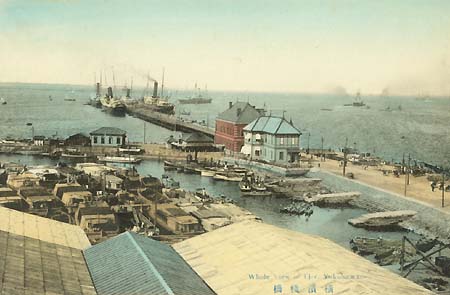 Yokohama pier (old card, coll. WS)
Yokohama pier (old card, coll. WS)
In Japan the Nippon Yusen Kaisha (NYK) had been formed in 1865 by amalgamation of the Kiodo Ungu Kaisha and the Yubin Kisen Mitsubishi Kaisha. On the San Francisco route however the Toyo Kisen Kaisha was dominant with the "Tenyo Maru" and "Chiyo Maru" and the smaller "America Maru", "Hong Kong Maru" and "Nippon Maru".
Before WWI passengers could proceed also at Seattle from train to steamers either of the Northern Pacific, the Great Northern or the Nippon Yusen Kaisha for Japan and China. An advertisement of 1916 listed for services between Seattle, Victoria, Yokohama, Kobe, Shanghai and Hong Kong the twin-screw passenger steamers "Yokohama Maru" and "Shidzuoka Maru" of 13,000 tons each, "Inaba Maru" of 12,600 tons and "Kamakura Maru", "Sado Maru", "Awa Maru" and "Tamba Maru" of 12,500 tons each. During WWI their "Suwa Maru" (10,672 gt) and "Fushimi Maru" were temporarily transferred from the Suez - Europe to the Pacific route.
At Tacoma, passengers could take a steamer of the Osaka Shosen Kaisha to Yokohama, Hong Kong and Manila. That company was the biggest Japanese shipping firm, listing a fleet of 124 steamers in the year 1920, followed by the Nippon Yusen Kaisha with 102 vessels afloat (according to L. Dunn). At that time six black/white passenger-cargo steamers of the "Arabia Maru" class of c. 9,500 tons each represented their champions.
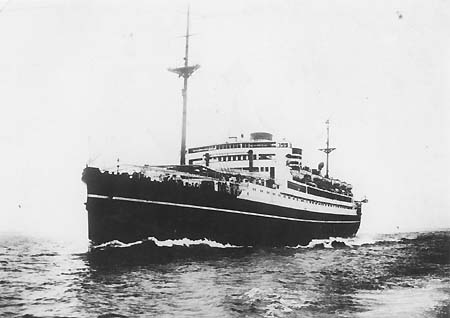 "Asama Maru" (official card, coll. WS)
"Asama Maru" (official card, coll. WS)
After WWI the Nippon Yusen Kaisha timetable showed services San Francisco - Honolulu - Yokohama - Kobe - Shanghai - Hong Kong - Manila. The services were alternating with the Toyo Kisen Kaisha, which was taken over in 1926. As the largest ship employed by Toyo Kisen Kaisha after WWI on the Tokyo - San Francisco route was described the "Tayo Maru", the former 14,500-ton "Cap Finisterre" of the Hamburg-Sued (sunk in 1992 by a U.S. submarine). In 1940 the "Nitta Maru" (17,150 gt) was completed for the trans-Pacific run of Nippon Yusen Kaisha. With the attack on Pearl Harbour in December 1941 every traffic ended. The fleet was requisitioned by the organization Senpaku Unei-Kai, generally used for wartime transports to and from the Pacific islands, China and Indochina. The "Nitta Maru" and her sisters "Kasuga Maru" and "Yawata Maru" however were rebuilt into the aircraft carriers "Chuyo", "Tayo" and "Unyo" (according to Weyers Flottentaschenbuch). With the end of WWII, the Japanese fleet of ocean liners had practically ceased to exist.
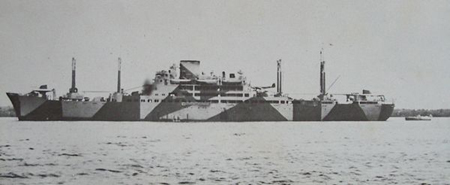 "Aikoku Maru" at Seletar, August 1942, sunk at Truk 1944 (via Wikimedia)
"Aikoku Maru" at Seletar, August 1942, sunk at Truk 1944 (via Wikimedia)
Japan - South America
Even during WWI "The Official Guide of the Railways & Steam Navigation Lines of the United States" listed services by Toyo Kisen Kaisha between Japan, the American West Coast and South America. In the '30s passengers heading for ports in the Far East could board at Los Angeles a Nippon Yusen Kaisha ship which had come on a regular route from Valparaiso, Chile, and went to Yokohama and Hong Kong. The Osaka Shosen Kaisha started in the 1920's a new service to Argentina via the Cape of Good Hope. In 1951 they put in service the motor-ships "Argentina Maru" and Brazil Maru" for a long-haul route Kobe - Yokohama - Los Angeles - Panama Canal - Buenos Aires, which was maintained during the '60s by the amalgamated Mitsui O.S.K. Lines.
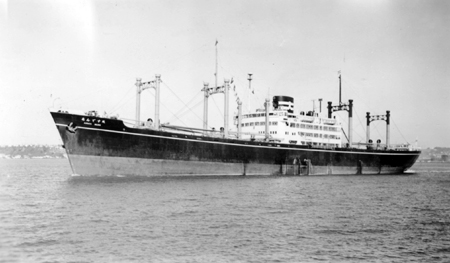 "Andes Maru", Osaka Shosen Kaisha (old card, coll. WS)
"Andes Maru", Osaka Shosen Kaisha (old card, coll. WS)
Final Destination Yokohama
Japan's important harbour of Yokohama was connected with nearby Tokyo by rail from 1872. In cooperation with the Nippon Yusen Kaisha special trains Tokyo - Yokohama Port for the Pacific and Kyoto - Kobe harbour for the Europe services were listed. Due to WWII, the new flagship "Nitta Maru" (1939/ 17,150 gt) did not take up service. Decades after the war, the only ship of the trans-Pacific fleet still afloat was the motor ship "Hikawa Maru" (11,622 gt). She had entered the Nippon Yusen Kaisha in 1930, was equipped in 1941 as a navy hospital ship, served U.S. troop transports after the war, resumed trans-Pacific service in 1950 and lay as a youth hostel at Yokohama Port since 1961. When the "Hikawa Maru" maintained still the route to America, the special train was running from Tokyo to Yokohama pier. However, as book author Charles S. Small reported, it was used rather by people saying farewell than by ocean travelers.
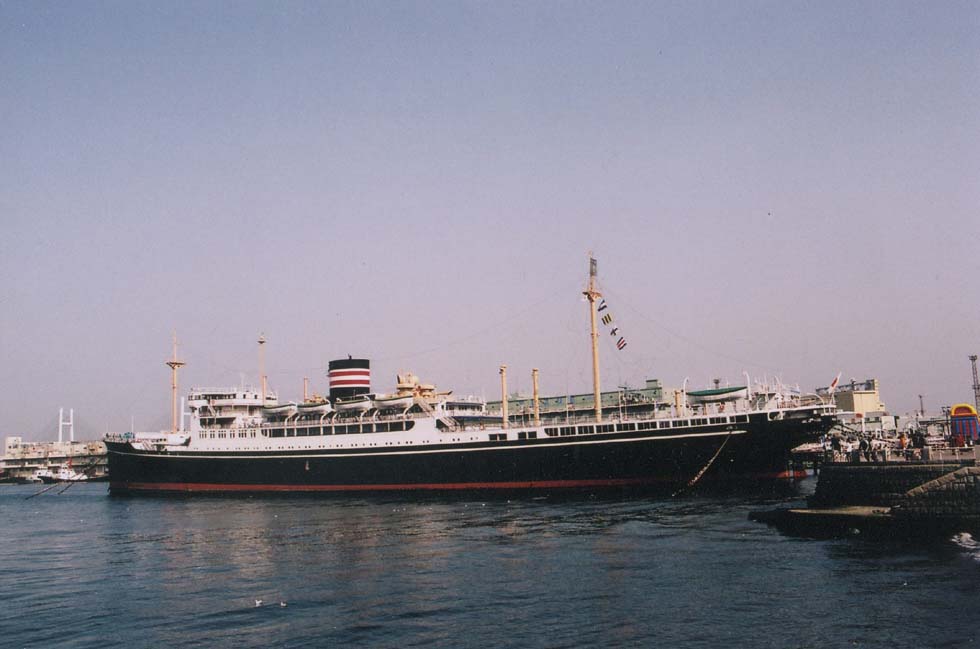
"Hikawa Maru", Yokohama 2006 (William Pearce)
Russia
The Tsar's Russian Voluntary Fleet had opened in 1880 a route from Odessa by the way of the Indian Ocean to Vladivostok. From 1908 the start of a service Vladivostok - Vancouver is reported (by TheShipsList). After the revolution and institution of Sovtorgflot, activities were concentrated on the seas close to the USSR.
Canadian Pacific
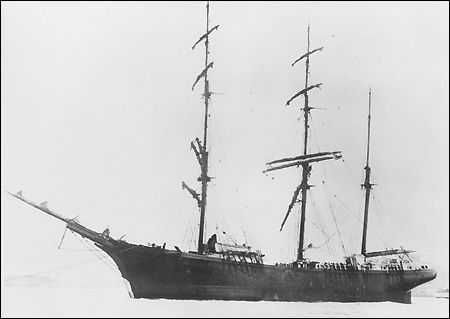 "W. B. Flint" or sister (archives Canadian Pacific)
"W. B. Flint" or sister (archives Canadian Pacific)
Canada was made a nation by completing the Canadian Pacific Railway, which reached the ocean at Port Moody in 1886 and Vancouver in 1887. They had already experience with shipping on the Great Lakes and a planned connection with the Far East appeared economically viable. The barque "W.P. Flint" was the first of seven chartered sailing vessels to arrive from Japan in July 1886. The further development was described by an official booklet: "... the Canadian Pacific came to an agreement with Sir William Pearce, then in control of the Fairfield Shipbuilding & Engineering Co, and the Guion Line, to operate this route with the "Abyssinia", "Batavia" and "Parthia". They had been built in 1870 for Cunard. The "Abyssinia" opened the route Vancouver - Yokohama in 1887 and in the following year Yokohama - San Francisco was added. That Canadian Pacific Steamship Line was only an interim solution, as historian C. Vernon Gibbs pointed out.
The Canadian Pacific Railway Co. commissioned three new sleek 6,000-ton steamers, white with two yellow funnels, the "Empress of India", "Empress of Japan" and "Empress of China", completed at Barrow in 1891. "The mail service (...) started when the "Empress of India" left Hong Kong on the 7th April 1891. The first mails were delivered in London 26 days after leaving Yokohama, more than two weeks faster than the Suez route", reported the official brochure. The route was praised also as Royal Mail S.S. Line. The "Empress of Russia" and the "Empress of Asia" (each 16,900 gt, 21knots), featuring three yellow funnels, were still faster and allowed therefore an extra call at Manila in 1914. The Canadian Pacific fleet on the Far East route was joined in 1922 by the beautiful 21,516-ton "Empress of Canada" from Fairfields and in 1923 by the "Empress of Australia". The latter, bought from the Reparations Commission initially as "Empress of China", had been commissioned by Hapag as "Admiral von Tirpitz". Each of these ships anchored at Woosung outside of Shanghai, whereas the smaller "Empresses" could berth at the Eastern Wharf. The "Empress of Australia" achieved fame during the horrible Yokohama earthquake disaster in 1923. For a week the vessel remained at Yokohama, supplying rescue teams to work in the town, as well as shelter to many hundreds of homeless people. In 1926 she became re-engined for the North Atlantic service. The bigger "Empress of Japan" (26,032 gt), completed by Fairfields in 1930, boasted a higher operation speed and like the re-engined "Empress of Canada" she could add a call at Honolulu - yet being a full day ahead of their rivals of the San Francisco route. Renamed "Empress of Scotland", she served during WWII as a trooper. The multiple losses the Canadian Pacific had suffered during WWII made it impossible to resume passenger services to the Far East after the end of hostilities.
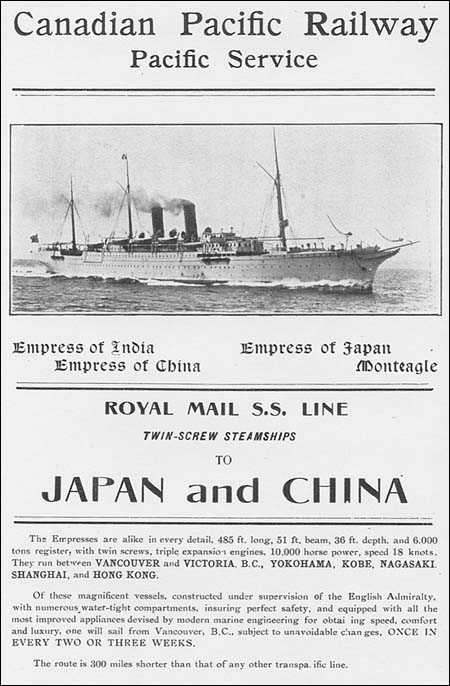 Canadian Pacific ad (coll. WS)
Canadian Pacific ad (coll. WS)
Luxury Liners
Between the wars, holiday trips from San Francisco and Los Angeles Long Beach to Hawaii got very popular. At Honolulu the passengers were welcomed with flower garlands from native girls in their colorful costumes...
For that traffic 'from Hollywood to Honolulu' the Los Angeles Steamship Company or LASSCO was founded in 1920, taking over two German war-prize ships from the U.S. Navy, introducing them as "City of Los Angeles" and "City of Honolulu". The white "City of Honolulu" had a bad fate: On her first return voyage she caught fire and sank, but everyone was rescued. In 1931 LASSCO was absorbed by Matson Lines (for more information see the book 'Hollywood to Honolulu', by Martin Cox and Gordon Ghareeb).
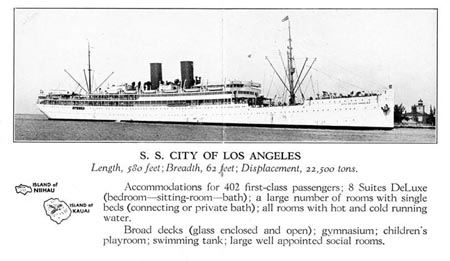
"City of Los Angeles", LASSCO ad of 1927 (via timetableimages)
|
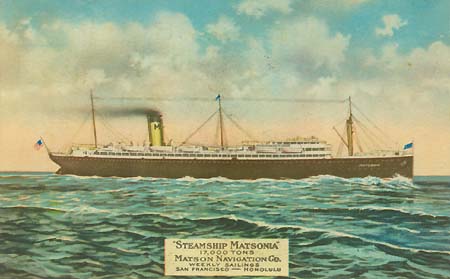
"Matsonia" for San Francisco - Honolulu sailings (old card, coll. WS)
|
The Matson Navigation Co. of San Francisco, had got interest also in the tourist business and ordered between 1908 and 1914 four steamers with additional passenger cabins. The first was the "Lurline" (5,928 gt), used on a San Francisco - Hawaii route until 1932. In the meantime Matson Lines had commissioned for 1st class services to Hawaii new beautiful steamers, white-painted with two buff funnels, the "Malolo" (16,435 gt) of 1927 (later becoming the second "Matsonia", in 1948 "Atlantic" of Home Lines, in 1955 "Queen Frederica" of the National Hellenic American Line, in 1960 refurbished by Chandris), the "Mariposa" II (18,563 gt) of 1931 (the later "Homeric" of Home Lines), the "Monterey" (18,017 gt) of 1932 (introduced on a maiden voyage San Francisco - Honolulu - Sydney, resuming Honolulu services as "Matsonia" II in 1957, renamed "Lurline" III in 1963 and then "Britanis" of Chandris in 1970). Famous for her elegance was the "Lurline" II (18,565 gt, 20 knots) of 1932, her interiors and even exterior features designed in a modern style by Raymond Loewy. A luxurious connecting train from Chicago with Pullman sleeping-cars is reported by railway historian Arthur D. Dubin. Also after the "Lurline" (II) had been acquired by Chandris in 1963, she represented the old noblesse under her new name "Ellinis".
A competitor of Matson Lines had emerged with the Hawaiian SS Co., founded in 1954. Their "Leilani", introduced in 1956 on Honolulu services, was a handsome steamer of 18,298 tons with two funnels, built in 1944 as "General W.P. Richardson" for the U.S. Navy. In 1958 the Textron Inc., mother of the Hawaiian SS Co., went bankrupt and the "Leilani" was taken over by the U.S. Maritime Administration.
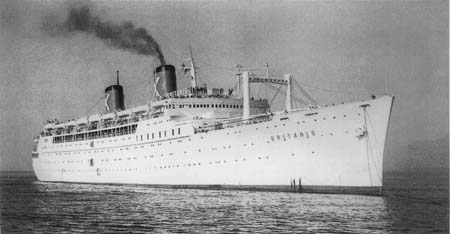
The former "Monterey" as "Britanis" of Chandris (source unknown)
|
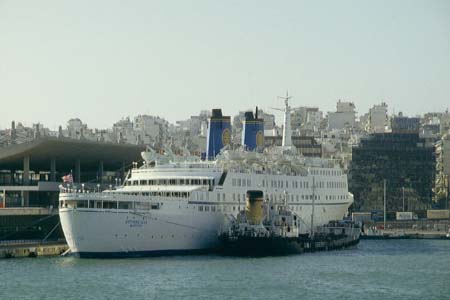
The former "President Roosevelt", as "Sapphire Seas" at Piraeus in 1994 (WS)
|
The American President Lines had introduced in 1947 the "President Cleveland" and "President Wilson" (15,437 gt), nice steamers with two funnels, employed on the route San Francisco - Los Angeles - Hong Kong - Manila - Yokohama. In 1960 the above-mentioned "President Roosevelt" was acquired and, rebuilt into a beautiful luxury liner. She had her maiden voyage San Francisco - Yokohama in 1962. In 1965, the smaller "President Hoover" (10,603 gt) of 1939 was sold to Chandris, becoming the "Regina". The career of the beautiful "President Roosevelt" deserves a special note: after having served Navy and Army, the former "General W.P. Richardson" was refurbished as "La Guardia" (according to Bonsor), chartered in 1949 by American Export Lines until 1951, then employed as "Laguardia" by the Military Sea Transportation Service (see chapter North Atlantic), in 1956 rebuilt as "Leilani" for the Hawaiian S.S. Co., in 1961 rebuilt as "President Roosevelt" (18,920 gt) for American President Lines, in 1970 refurbished as "Atlantis" for Chandris, from 1972 operated as "Emerald Seas" by Admiral Cruises, then she cruised as "Sapphire Seas", "Ocean Explorer I" and in late 2004 she was transferred to Alang scrapyard after six decades of service.
After the end of most trans-oceanic passenger lines, ABC Shipping Guide of 1978/79 showed on the San Francisco - Far East route only one last service by the modest "Enna G" of the Nauru Pacific Line to the Marshall and Mariana Islands.
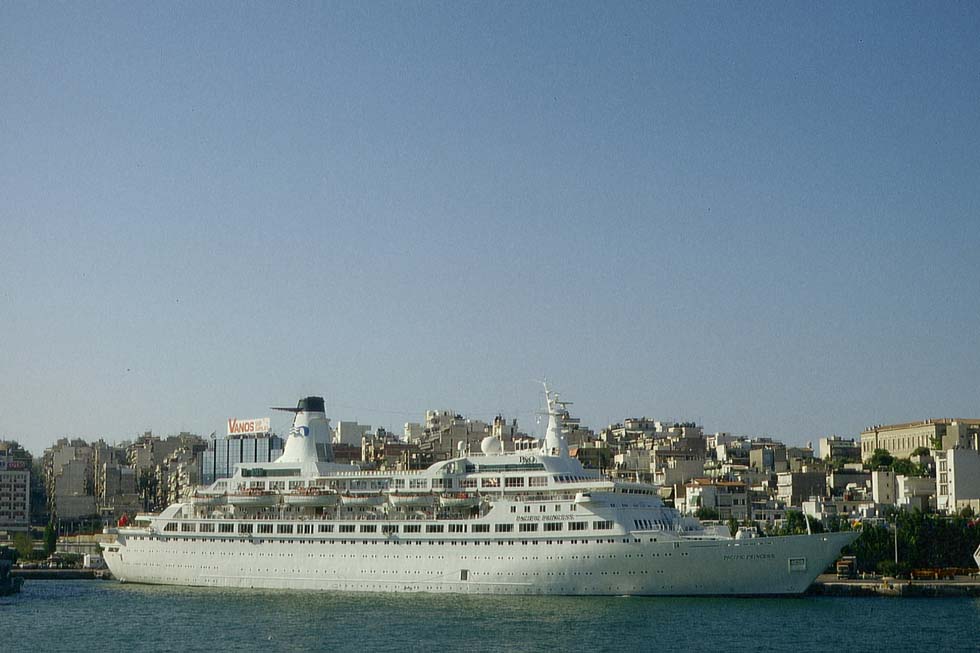
"Pacific Princess" (ex "Sea Venture"), Piraeus 1994 (WS)
On the route Los Angeles - Tahiti - New Zealand - Sydney, Princess Cruises appeared in the ABC, still offering not only complete cruises, but also trips with one-way ticketing. Their "Island Princess" (19,907 gt) and "Pacific Princess" (20,636 gt) had been acquired by P&O in 1974/75 from the company Norwegian Cruiseships. Now the beauty of the Pacific can be admired during a wonderful cruise aboard a mega-ship or a luxury yacht.
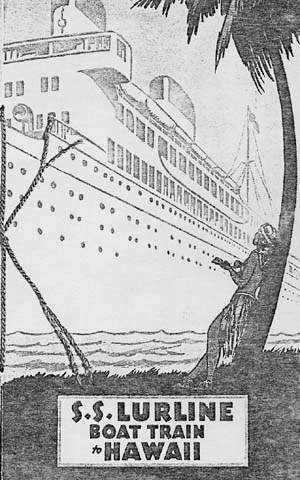
|
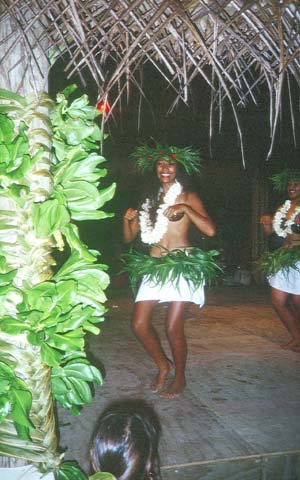
|
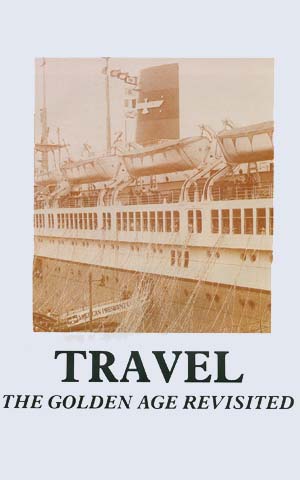
|
|
Left: "Lurline" ad (coll. A.D. Dubin). Right: American President Lines (Port Hong Kong)
|
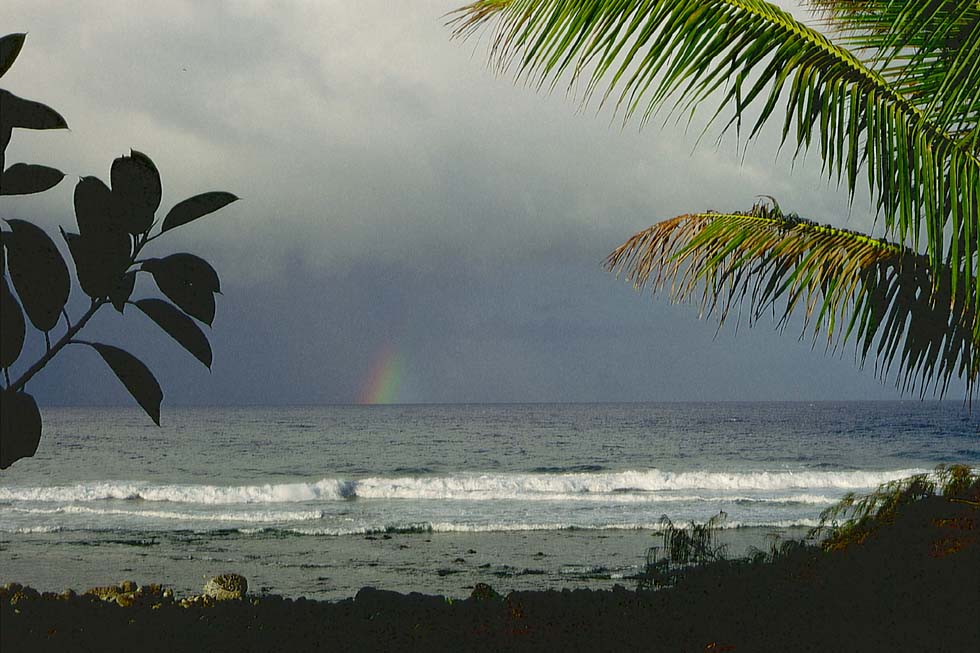
Rarotonga, Cook Islands (WS)
|